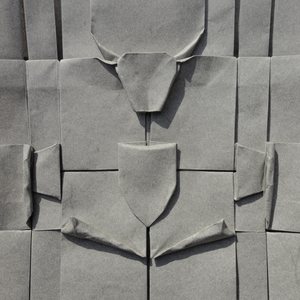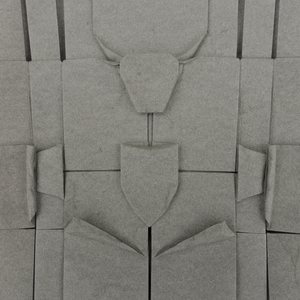Butchers’ Guild Coat of Arms


This model started out something completely different that what it ended up being. Originally, I planned to make a model of Lublin Castle, and started with the two axes which decorate its main gate. Then, I thought about adding some more weaponry (hence the shield), and then the design evolved slowly into its final version, a composition resembling a coat of arms of a medieval guild.
The two pictures shown here highlight how much lighting affects a model’s final appearance when photographed. The first picture was taken in direct sunlight: deep shadows hide some detail, but they clearly show the bas-relief-like sculpture and all three-dimensional elements. The second picture was taken in the shade, and the diffuse light arrives at almost all points evenly, visually flattening the image.
Models such as this one, a genre I call origami paintings, pose interesting challenges when you try to classify them. Traditional tessellations consist of multiple repetitions of the same molecule, so even though the number and arrangement of the molecules can vary each time the models is folded, it is easy to recognize that it’s “the same model”. In a complex composition such as this one, many elements could be used as tessellation molecules independently of each other: I could “extract” a Shield Tessellation, Ox Head Tessellation, Axe Tessellation, etc. from this model, and they could each make an interesting design. I could also create other origami paintings by taking the same elements and arranging them in different ways. Such designs pose important questions about a design’s definition, the border when design becomes another, remixing of elements in order to create something new, and model authorship. Such issues also arise with abstract designs: there are quite a few models which can all be called variants of Fujimoto’s Hydrangea, with varying amount of modification and input from other authors.
Comments